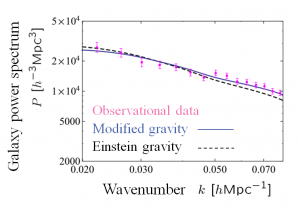Should Einstein be modified? Probing cosmic evolution through the new neutrino mass

The discovery of accelerated cosmic expansion has had a huge impact on contemporary physics and its origin is being actively investigated, but current theory has been unable to explain why it is taking place. The simplest way of accounting for accelerated expansion is to introduce a tiny cosmological term to the Einstein equation in general relativity, but its required magnitude is so tiny that alternative theories such as modified gravity have been widely studied as well.

Power spectrum of galactic distribution as a function of a wavenumber. © Hayato Motohashi
Modified gravity is in good agreement with observational data, while Einstein gravity is not.
H. Motohashi, A. Starobinsky, and J. Yokoyama of Research Center for the Early Universe at the University of Tokyo recently reanalyzed the observational data of large-scale cosmic structures and cosmic microwave background anisotropy, assuming the existence of a new species of cosmic neutrino with mass about one-billionth of a hydrogen atom as inferred from a number of recent particle-physics experiments. They found that the cosmological model based on Einstein’s general relativity is inconsistent with the observed distribution of galaxies and clusters of galaxies, whereas the modified gravity theory can successfully account for both accelerated cosmic expansion and observational data of large-scale structures.
This means that, if the existence of such a new massive neutrino species is confirmed by further neutrino experiments, the issue of cosmic acceleration may be solved and the need for modification of Einstein’s gravity will be confirmed.
Ppress release (Japanese)
Paper
Hayato Motohashi, Alexei A. Starobinsky, Jun’ichi Yokoyama,
“Cosmology based on f(R) gravity admits 1 eV sterile neutrinos”,
Physical Review Letters 110 (2013) 121302. doi: 10.1103/PhysRevLett.110.121302.
Article link
Links
Research Center for the Early Universe
Jun’ichi Yokoyama’s website (Japanese)







